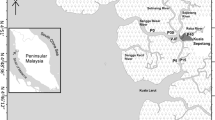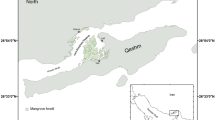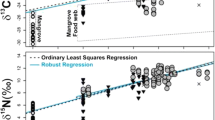Abstract
Stable isotope analysis of carbon has been proposed as a means for discerning the incorporation of terrestrial forest detritus into aquatic foodwebs, and as such, has the potential to be used as a biomonitor of the aquatic effects of riparian deforestation. A synthesis of 13C/12C data from the literature indicates, however, that the scope for successful use of carbon isotope analysis in separating allochthonous and autochthonous food provenance is much more limited than was once thought. This occurs due the overlap in carbon isotope ratios between terrestrial forest detritus and those of both lotic attached algae and lentic filamentous attached algae. Only within rockyshored, oligotrophic lakes without macrophytes, and forest-fringed estuaries and lagoons, where the carbon isotope ratios for attached algae and forest detritus are significantly different, is there any likelihood of discerning the incorporation of allochthonous carbon into aquatic foodwebs using 13C/12C values alone.
Similar content being viewed by others
References
Araujo-Lima, C., B. R. Forsberg, R. Victoria & L. Mortinelli, 1986. Energy sources for detritivorous fishes in the Amazon. Science 234: 1256–1258.
Bird, M. I., W. S. Fyfe, D. Pinheiro-Dick & A. R. Chivas, 1992. Carbon isotope indicators of catchment vegetation in the Braz. Amazon. Glob. Biogeochem. Cycl. 6: 293–306.
Bunn, S. E. & P. I. Boon, 1993. What sources of organic carbon drive food webs in billabongs? A study based on stable isotope analysis. Oecologia 96: 85–94.
Bunn, S. E., D. R. Barton, H. B. N. Hynes, G. Power & M. A. Pope, 1989. Stable isotope analysis of carbon flow in a tundra river system. Can. J. Fish. aquat. Sci. 46: 1769–1775.
Cooperman, J., 1993. Cutting down Canada. In Devell (ed.), B. Clearcut: the tragedy of industrial forestry. Sierra Club Books/Earth Island Press. 289 pp.
Currin, C. A., S. Y. Newell & H. W. Paerl, 1995. The role of standing dead Spartina alterniflora and benthic microalgae in salt marsh food webs: considerations based on multiple stable isotope analysis. Mar. Ecol. Prog. Ser. 121: 99–116.
Forsberg, B. R., C. Araujo-Lima, L. A. Martinelli, R. L. Victoria & J. A. Bonassi, Autotrophic carbon sources for fish of the central Amazon. Ecology 74: 643–652.
France, R., 1995a. Critical examination of stable isotope analysis as a means for tracing carbon pathways in stream ecosystems. Can. J. Fish. aquat. Sci. 52: 651–656.
France, R., 1995b. Carbon-13 enrichment in benthic algae: foodweb implications. Mar. Ecol. Prog. Ser. 124: 307–312.
France, R., 1995c. Differentiation between littoral and pelagic foodwebs in lakes using stable carbon isotopes. Limnol. Oceanogr. 40: 1310–1313.
France, R., 1995d. Stable isotope survey of the role of macrophytes in the carbon flow of aquatic foodwebs. Vegetatio in press.
France, R., 1995e. Source variability in σ15N of autotrophs as a potential aid in measuring allochthony in freshwaters. Ecography 18: 318–320.
France, R. & R. Peters, 1995. Predictive model of the effects on lake metabolism of decreased airborne litterfall through riparian deforestation. Conserv. Biol. 9: 1578–1586.
Fry, B. & E. B. Sheff, 1984.σ13c measurements as indicators of carbon flow in marine and freshwater ecosystems. Contrib. Mar. Sci. 27: 15–47.
Hackney, C. T. & E. B. Haines, 1980. Stable carbon isotope composition of fauna and organic matter collected in a Mississippi estuary. Estuar. Coast. Mar. Sci. 10: 703–708.
Hamilton, S. K., W. M. Lewis & S. J. Sippel, 1992. Energy sources for aquatic animals in the Orinoco River floodplain: evidence from stable isotopes. Oecologia 89: 324–330.
Keeley, J. E. & D. R. Sandquist, 1992. Carbon: freshwater plants. Plant, Cell Envir. 15: 1021–1035.
Lugo, A. E. & G. Cintron, 1975. The mangrove forests of Puerto Rico and their management. In Walsh, G. E, S. C. Snedaker & H. J. Teal (eds), Proc. Int. Symp. Biol. Mgmt Mangroves. Vol. II. University of Florida: 825–846.
McCory, C., 1993. Canada-Brazil of the North. In Devell, B. Clearcut: the tragedy of industrial forestry. Sierra Club Books/Earth island Press. 289 pp.
McLaren, C., 1990. Heartwood. Equinox 53: 42–55.
Neill, C. & J. C. Cornwell, 1992. Stable carbon, nitrogen, and sulfur isotopes in a prairie marsh food web. Wetlands 12: 217–224.
Odum, W. E. & E. J. Heald, 1972. Trophic analyses of an estuarine mangrove community. Bull. Mar. Sci. 22: 671–738.
Peterson, B. J. & B. Fry, 1987. Stable isotopes in ecosystem studies. Annu. Rev. Ecol. Systemat. 18: 293–320.
Rodelli, M. R., J. N. Gearing, P. J. Gearing, N. Marshall & A. Sasekumar, 1984. Stable isotope ratio as a tracer of mangrove carbon in Malaysian ecosystems. Oceologia 61: 326–333.
Rounick, J. S. & M. J. Winterbourn, 1986. Stable carbon isotopes and carbon flow in ecosystems. Bioscience 36: 171–177.
Rounick, J. S., M. J. Winterbourn & G. L. Lyon, 1982. Differential utilization of allochthonous and autochthonous inputs by aquatic invertebrates in some New Zealand streams: a stable isotope study. Oikos 39: 191–198.
Stoner, A. W. & R. J. Zimmerman, 1988. Food pathways associated with penaeid shrimps in a mangrove-fringed estuary. Fish. Bull. 86: 543–551.
Teal, J. M., 1962. Energy flow in the salt marsh ecosystem of Georgia. Ecology 43: 614–624.
Vanote, R. L., G. W. Minshall, K. W. Cummins, J. R. Sedell & C. E. Cushing, 1980. The river continum concept. Can. J. Fish. aquat. Sci. 37: 130–137.
Wada, E., Y. Kabaya & Y. Kurihara, 1993. Stable isotope structure of aquatic ecosystems. J. Biosci. 18: 483–499.
Winterbourn, M. J. & J. S. Rounick, 1985. Benthic faunas and food resources in small New Zealand streams subjected to different forestry practises. Verh. int. Ver. Limnol. 22: 2148–2152.
Author information
Authors and Affiliations
Rights and permissions
About this article
Cite this article
France, R.L. Scope for use of stable carbon isotopes in discerning the incorporation of forest detritus into aquatic foodwebs. Hydrobiologia 325, 219–222 (1996). https://doi.org/10.1007/BF00014987
Received:
Revised:
Accepted:
Issue Date:
DOI: https://doi.org/10.1007/BF00014987




